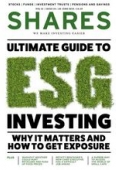Archived article
Please note that tax, investment, pension and ISA rules can change and the information and any views contained in this article may now be inaccurate.
Tracking the S in ESG: what you need to know about social factors investing

Perhaps the lesser sung of the ESG playlist, experts hope that social factors will start to emerge from the chorus line to take a more centre stage spot in investment selection and performance.
The social leg of the ESG stool has typically focused on areas like worker rights, equal opportunities and gender pay equality but the reality is that social factors are a far more broad a complex collection of issues.
‘Social looks at things like working conditions, including child labour and employee diversity, a business’ interaction with local communities and health and safety issues,’ say experts at M&G Investments.
But while many organisations have made significant strides forward in environmental and governance reporting, measuring social factors has been largely left behind.
THE WEAK LINK
‘The S in ESG has been the weak link in investment analysis so far, and investors have lacked a shared framework to assess companies’ approaches,’ says Sharan Burrow, general secretary of the International Trade Union Confederation, a global worker’s rights organisation.
In a study of 12 leading ESG frameworks in March 2017 the NYU Stern Center for Business and Human Rights found that despite the growing interest in ESG investing, reporting of the social element had failed to keep up with reporting on environmental and governance issues.
‘Measuring things that are complex, multidimensional and sometimes intangible is a unique challenge,’ say study authors Casey O’Connor and Sarah Lebowitz.
‘Social phenomena is inherently reductive in a way that measuring revenue is not.’
Uber refusing to give holiday or sick pay rights to drivers, Facebook selling user data without permission, or a supermarket’s overuse of plastic in product packaging might all be seen as social issues in varying guises.
What they share is a reputational risk to the organisations in question, a breakdown in trust that could cost sales, lose customers and see business partners (such as advertisers) walk away.
HARD FACT AND SUBJECTIVE IMPRESSIONS
The fact that many social issues must be assessed qualitatively rather than quantitatively is another gap in the analysis process.
Lara Blecher, shareholder engagement executive at investor adviser group PIRC, uses low trade union membership as an example. ‘It could be that people feel comfortable enough with approaching their employers so they don’t feel the need to join a trade union,’ she says.
But it could equally be that staff have been bullied away from trade unions and are too scared to do so. ‘Unless you have a good qualitative grasp of the issues, you don’t have a great sense of what’s going on,’ says Blecher.
When it comes to evaluating companies on their toxic waste emissions (environmental) or vulnerability to fraud and corruption (governance), investors now have tools to assist them.
But The NYU Stern analysis shows that social measurement almost exclusively targets efforts, not effects.
‘Only 8% of the more than 1,700 “S” indicators we examined evaluated the effects of company practices,’ say O’Connor and Lebowitz. The other 92% of indicators look at areas like policies or commitments, conducting audits, risk assessments, training or other collaborative and stakeholder engagement actions, but with little or no heed paid to the actual impact they have.
This filters through to limited tools for investors. According to the NYU Stern study just 14% of social ratings products aggregated by the Global Initiative for Sustainability Reporting target investors.
‘This suggests either that investors do not believe these factors are likely to improve investment outcomes (and therefore do not demand social products and services), or that there is something about social factors that make them difficult to package for investor use,’ says the report.
IMPACT ON RETURNS
Understanding what to measure, and how to measure it, is part of the puzzle but social factors’ impact on returns is also to be determined.
That leaves company bosses with an uncomfortable problem; prioritise long-term goals first for the good of the company and broader society, but risk short-term performance that could put their own jobs at risk.
There are also timeframes to be considered. The impact of social investments might take years to manifest themselves. ‘Measuring customer satisfaction levels, or the value of intangibles, such as investment in innovation, brand recognition or culture, are things companies and investors have been able to do, despite their complexity,’ notes the NYU Stern study.
Companies now need to find a way to report progress on social factors and impact ‘in a way that allows investors to see a good trajectory for their investment purposes,’ says Blecher.
NYU Stern authors O’Connor and Lebowitz accept that plenty of heavy lifting is still needed but they remain optimistic. ‘With sufficient demand and ingenuity, there is every reason to believe that the challenge of developing sound, easy-to-use measurements for “S” can be overcome,’ even if it does require a different approach.
The NYU Stern study highlights four areas where companies, and the ESG industry, should focus in a bid to move social reporting forward:
1. Measure real-world effects, not just efforts
2. Diversify the data – the ESG industry should look beyond the information provided by companies, such as data from trade associations
3. Establish and rely upon clear standards for evaluating social impacts. O’Connor and Lebowitz suggest industry-specific frameworks
4. Target investors as the primary audience. Companies and the ESG industry need to package their social data with investors in mind.
Important information:
These articles are provided by Shares magazine which is published by AJ Bell Media, a part of AJ Bell. Shares is not written by AJ Bell.
Shares is provided for your general information and use and is not a personal recommendation to invest. It is not intended to be relied upon by you in making or not making any investment decisions. The investments referred to in these articles will not be suitable for all investors. If in doubt please seek appropriate independent financial advice.
Investors acting on the information in these articles do so at their own risk and AJ Bell Media and its staff do not accept liability for losses suffered by investors as a result of their investment decisions.

 magazine
magazine










